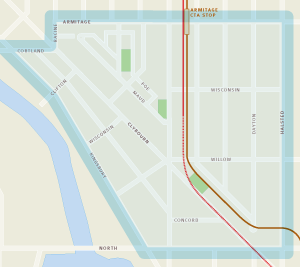For more than 130 years residents have shopped this unique commercial community. Visual clues reveal a colorful and even scandalous past in one of Chicago’s first shopping districts. It is a rich story that includes the handiwork of a world-famous architect, a secret tunnel and the serene faces of a mother and child gazing down on unsuspecting pedestrians.
The settlers of “Center” Street, as it was called, are long gone but many of the buildings and even some of the businesses remain. In the 1870’s-80’s a horse- drawn trolley lumbered down Center Street. By 1890 the trolley was electrified and the Avenue was re-named after Thomas Armitage, an American Clergyman and the founder of the American Bible Union.
In 1900 the Armitage El Station opened its doors and today it is one of the oldest train stations in continuous operation in the United States. The El platform offers a wonderful view of the commercial district. The pressed metal cornices, bay windows and turrets, terra-cotta ornament and stone patterning reveal a rare intact Victorian streetscape that is unparalleled in the Midwest and led to its landmarking in 2002.
By 1905 Armitage/Halsted was mostly commercial when the neighborhood acquired a building with an imp(ressive pedigree. Look up as you enter Pasta Palazzo (1966 N. Halsted) and notice the terracotta ornament spanning the entry. The casting mold is based on the intricate decoration of then unknown architect Louis H. Sullivan. In 1915 the Gepperth Brothers (1964 N. Halsted) opened their meat market, advertising “old time service.” Owner Otto Demke and family preside over the business he bought from the original owners in 1981. Otto says as recently as 1960 customers used to go into what is now the parking lot and select a live chicken that was “prepared” while they waited. Large hooks above the threshold used to hold fresh ducks at the holidays.
Today the market follows the same exacting standards of its Hungarian founders though Otto admits the chickens are no longer “plucked to order.” Ironically, as if they were posing for a portrait, a mother and child grace the façade of a building now housing Classic Kids – a photography studio. 917 W. Armitage has a distinctive stone lunette or arch showing the builder’s name, Hibler, and a special date. Let your eye travel up a few feet and you see the calm faces of Mrs. Mathew Hibler and her first child. Matt who was born in 1885, the year his father completed the building. Dan O’Donnell can take you out a hidden exit of Armitage Hardware (925 W. Armitage) if you know the secret password. His building on the corner of Armitage and Bissell was first a general store in 1896, before it became a hardware store in 1922. It was also a speakeasy. The basement is actually linked to several adjacent buildings via a secret tunnel. “Hardware” customers were quickly escorted out to the Bissell Street alley when Chicago Police unexpectedly arrived. Rumor has it Al Capone ran a combination tavern/funeral parlor across the street. Cretors Popcorn Company at the corner of Racine and Armitage was reportedly an early inventor of rolling popcorn machines.
At Armitage and Seminary Strongin Brothers, Inc. was the original candy cane manufacturer. Harry Houdini was said to have staged an escape from the basement of the old Police Station two blocks north on Halsted, now a video game venue. There are many more facts and fables you can ask current store owners about. The names change and businesses come and go. But Armitage remains a neighborhood behind the storefronts making RANCH livable and unique for more than a century. We are linked with residents who lived and worked here a generation ago just as we will touch those yet to come. This is our shopping district now and we are continuing to write its story.
Thanks to Commission on Chicago Landmarks, Old Town School of Folk Music, Chicago Historical Society, Lincoln Park Area Chamber of Commerce and Hallee Patterson.
Reproduced from RANCH Reporter Newsletter, 2005






